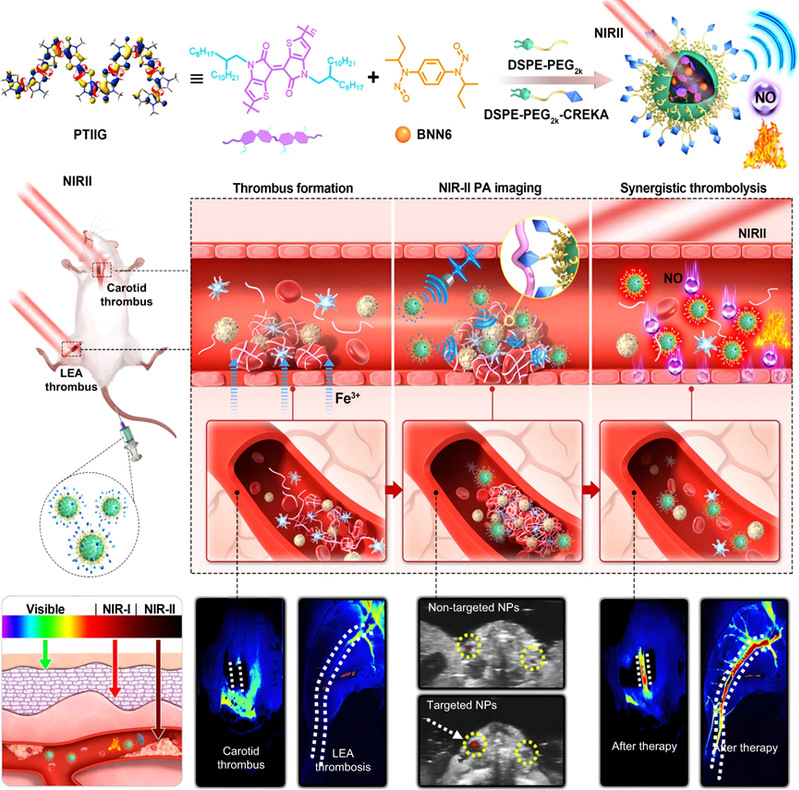NKU Team Makes Progress in Photo-triggered Synergistic Treatment of Thrombotic Diseases
Recently, the latest research findings in the realm of photo-triggered synergistic treatment of thrombotic diseases, conducted by Ji Qi, Deling Kong et al. from the State Key Laboratory of Medicinal Chemical Biology and the College of Life Sciences at Nankai University, were published in Nature Communications, a world-renowned journal, with the title “Near-infrared-II photoacoustic imaging and photo-triggered synergistic treatment of thrombosis via fibrin-specific homopolymer nanoparticles”. The team designed and developed a novel organic molecular probe with remarkable thrombus-targeting capabilities. This innovation not only enabled the high-resolution visualization with long-wavelength second near-infrared (NIR-II) photoacoustic imaging in vivo but also facilitated the synergistic treatment of thrombosis through thermophoresis and controlled release of nitric oxide.

In this project, a novel semiconductor homopolymer composed of a single unit was meticulously designed and synthesized. The intermolecular repulsion effect facilitates molecular motion, promoting efficient photothermal and photoacoustic conversion. The polymer was assembled with a thermal-response nitric oxide precursor molecule and modified fibrin-targeting peptides on the surface to prepare a nanomaterial system with thrombosis-targeting capabilities. Through comparative experimental investigations in vitro and on live animals, it was found that long-wavelength NIR-II photoacoustic imaging has unique advantages in thrombus diagnosis. This imaging technique improves the tissue penetration depth and spatial resolution and mitigate background noise interference, resulting in an exceptional diagnostic effect. It also enables high-resolution imaging of the treatment process of thrombosis. The spatiotemporal controlled photothermal effect induces thermophoresis and nitric oxide release, contributing to the synergistic treatment of thrombus. This strategy emerges as a promising option for thrombolysis and prevention of recurrence, surpassing the therapeutic efficacy of clinically used drugs like urokinase. Notably, it demonstrated significant therapeutic effects in animal models of carotid artery and lower extremity arterial thrombosis, underscoring its potential as a highly effective treatment modality.

Figure: Schematic illustration of the novel organic nanoprobes for long-wavelength NIR-II photoacoustic imaging and photo-triggered synergistic treatment of thrombosis and high-resolution visualization of the treatment process
This study highlights the remarkable attributes of the organic nanomaterial system, which leverages long-wavelength NIR-II photoacoustic imaging for both diagnostic visualization and treatment. The system demonstrates an exceptional light absorption coefficient, producing a vivid photoacoustic signal with strong tissue penetration and superior thrombus targeting capabilities, enabling the delineation of thrombus with ultra-high signal-to-noise ratio. Beyond its outstanding thrombus detection capabilities, the system exhibits potent antithrombotic activity, marking a groundbreaking achievement in achieving both precise thrombus diagnosis and collaborative treatment visualization using long-wavelength NIR-II photoacoustic imaging in vivo. The integration of thrombus-localized photothermal effect and on-demand nitric oxide release proves highly effective in thrombus dissolution, and also promotes the penetration of nanoparticles into thrombus, thereby boosting the antithrombotic effect. Importantly, this non-invasive near-infrared photo-triggered thrombolysis system has good biocompatibility and a low risk of hemorrhagic side effect, representing a safe and promising approach for thrombolytic therapy.
Nankai University is the affiliation of the first author and corresponding unit of the project. Jianwen Song, a master’s student at the College of Life Sciences, is the first author of the paper. Professors Ji Qi and Deling Kong affiliated with the State Key Laboratory of Medicinal Chemical Biology and the College of Life Sciences at Nankai University, along with Professor Wen Li at the Institute of Biomedical Engineering of Chinese Academy of Medical Sciences & Peking Union Medical College are the corresponding authors of this paper.
Link:
https://www.nature.com/articles/s41467-023-42691-8
(Edited and translated by Nankai News Team.)









